Nikolay Goldobin and the Interminable Doghouse
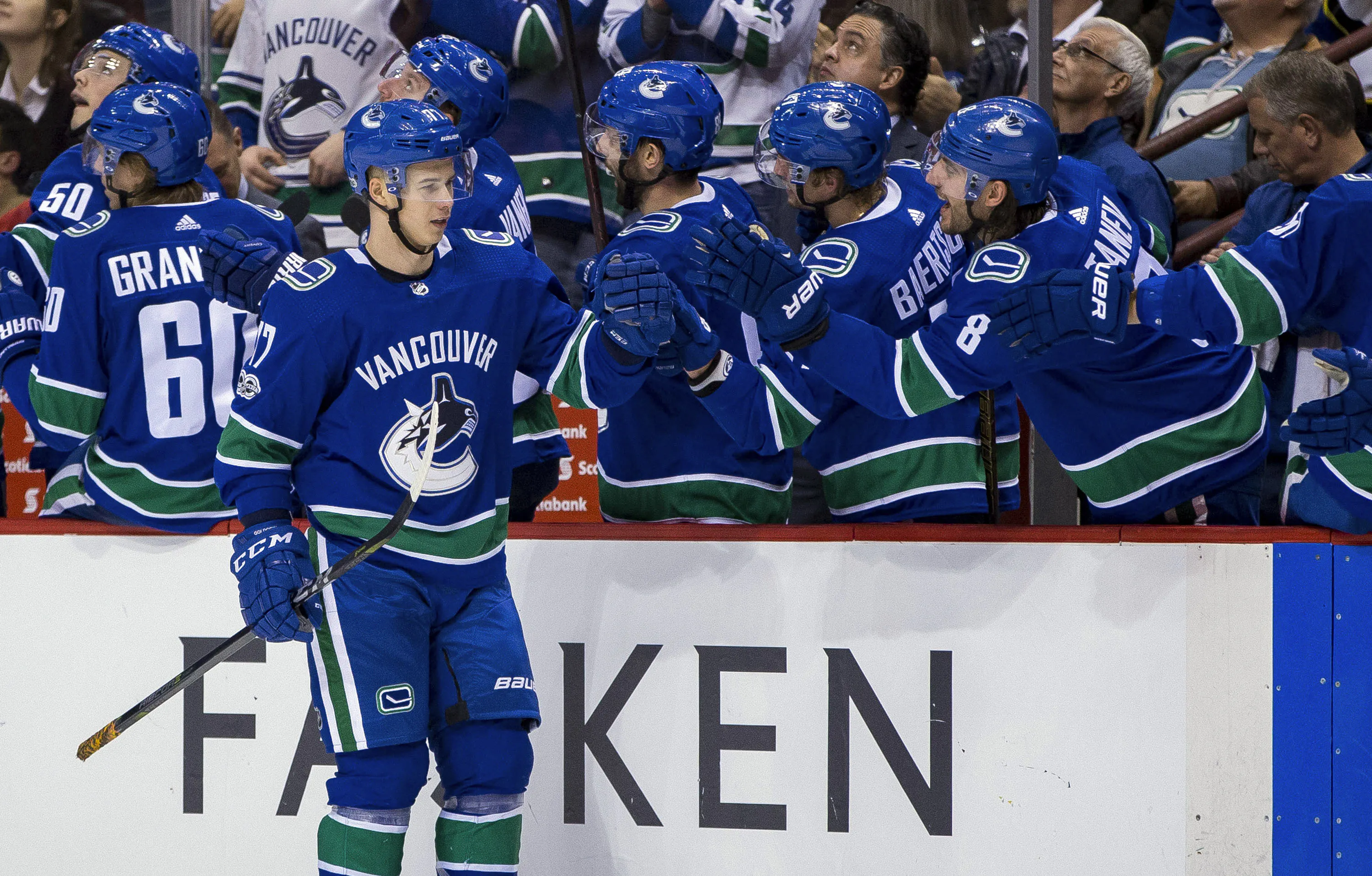
Nikolay Goldobin likes his new city. He told us so in his recent TV commercial for Capilano Audi. From the mountains to the ocean to the pulsing energy of downtown to the practice rink in Surrey to the pressbox at Rogers Arena, Nikolay Goldobin is a happy guy.
But he doesn’t like being picked on. Who among us does? Last week, Goldobin – still the Canucks fourth-highest scorer – was mired in a lengthy spell of healthy scratches when the Canucks leaked a story about Goldy being shown a series of clips of him not playing tight enough defensively. He reportedly asked, “why are you picking on me?”
I don’t know how much truth there is in the story, and I’m not sure why the organization chose to leak it. The predictable response from most fans was to read Goldy as lazy and unwilling to accept that he needs to improve his game. But many of the reporters who follow the team have seen from the 23-year old winger a genuine commitment to improving. Last season he spent several months in Utica working on his skating, his defensive game, killing penalties and earning the praise of his coach Trent Cull.
He arrived in camp this season ready to go, and quickly found chemistry with the alien prophet we call Elias Pettersson. He played the best hockey of his career this fall, racking up points on what was unquestionably the Canucks best line: Goldobin, Pettersson and Brock Boeser.
But when the Canucks acquired Josh Leivo from the Toronto Maple Leafs in November, Goldobin was abruptly booted off that line and his production started to decline. As his production dipped, it became clear that coach Travis Green was unhappy with his defensive play. The relationship between coach and played spiraled downward, Goldy found himself demoted to the fourth line, often benched in games (even, in one case, after setting up a goal), and ultimately scratched from the lineup.
To some, Goldobin should be a key piece in the Canucks rebuild, a player who has vision and creativity and moves quietly into soft areas to generate scoring chances at a higher rate than most players not named Elias Pettersson. To others, he is a lazy, defensive liability who should be jettisoned if he can’t earn the coach’s trust.
Spoiler alert: I’m in the first camp.
Goldygate
I like Goldy. I have from the start. It’s so much my brand that even I sometimes wish he would be traded so that I could move on from this drama. (No, I don’t. Don’t trade him. Don’t. Don’t you dare trade him for Michael Ferland. Just don’t.)
In the midst of one of the most depressing NHL seasons I have ever witnessed, Goldy arrived on the scene telling us he liked to score goals and proceeded to score an electric breakaway goal to give the Canucks a 4-0 lead over Dustin-expletive-Brown and the LA Kings. It was the highlight of the season to that point.
And got benched for it.
Coach Willie, ever vigilant against fun hockey, took the opportunity of the kid’s first game with his new team to teach him a lesson in never cheating offensively, even when you have a 3-0 lead and even when you score a thrilling goal. (The Canucks scored the second fewest goals in the NHL in 2016-17).
From that moment, I couldn’t help but have a soft spot for Goldy. The injustice felt palpable, and most of the fanbase was sick of Willie Desjardins’ brand of grind-out-overtime-losses hockey, where Michael Chaput was deployed with the Sedins and Nikita Tryamkin was run out of town for not playing like Chris Pronger. Goldy probably could have asked “why are you picking on me?” in that moment and it would be a fair question. He didn’t, as far as we know, and Desjardins was fired in the off-season.
But the narrative stuck, as the new coach seemed to pick up where his predecessor left off, with respect to Goldobin. Goldy was criticized for lacking a 200-foot-game, for his play away from the puck, and also for lackluster production. He was benched, he was scratched, he was sent down to Utica. It always seemed an exaggerated hard-line that was not applied as stridently to other players, but there was no denying that Goldy’s game had flaws – he did give up a lot defensively – and there was no harm in having him work on those flaws on the farm.
But this season has been different. The Sedins are gone and the Canucks have needed offense. The arrival of Elias Pettersson and Brock Boeser has helped, as has the continued growth of Bo Horvat into a capable offensive-centre and future captain. But Nikolay Goldobin, despite the benching and scratching, is number four in Canucks scoring. The production – which should be the primary expectation of a player like Goldobin – is there. His play away from the puck, though far from perfect, has made significant strides. And yet, no other player on the team gets criticized by the organization the way that Goldy does.
Fans and media, of course, are more divided. Goldy elicits polarized reactions, but so do other players, like Erik Gudbranson. These arguments typically fall along the great hockey faultline of our time: fancy stats versus the eye test. Old-School eye-testers see Gudbranson as a bruiser who can intimidate and out-muscle opposing forwards, stats nerds see a defender who gets utterly caved in nearly every appreciable metric. Eye-testers see Goldy as a defensive liability who can only produce with Pettersson, stats nerds see a player who drives offensive scoring chances, especially by finding shooters in a position to shoot (as measured by primary shot assists).
But while fans and media debate the merits of both players, the Canucks organization has never publicly breathed a word of criticism towards Gudbranson – quite the opposite in fact – whereas Goldy has been openly criticized throughout his stint in Vancouver.
In early January, Jason Botchford sat down with Goldobin and parts of the interview in The Athletties jumped out at me. I will pepper a few of Goldy’s comments into this, but first, it’s worth considering Botchford’s take:
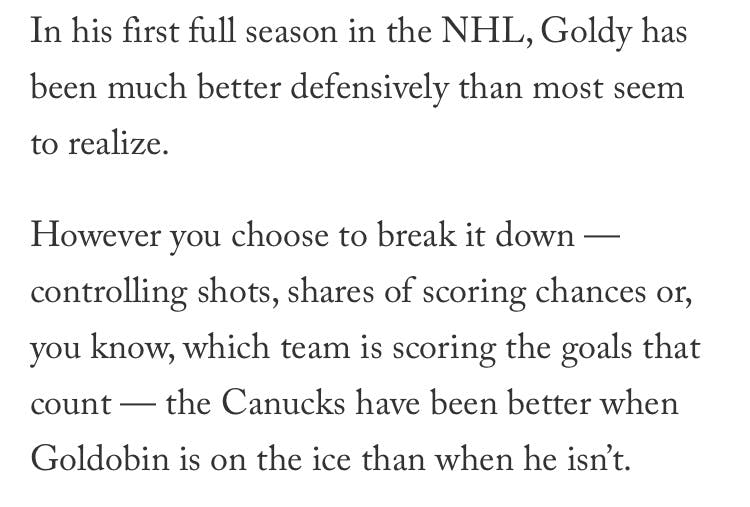
So, is Goldobin being picked on? Is the treatment he is receiving fair? Goldobin was on pace for a 45-point season when the string of healthy scratches started. Can we reasonably expect that other players would be treated similarly in similar positions?
I obviously don’t know, this is all somewhat hypothetical, because there is only one Goldy, and the player-coach relationship is complex. Travis Green is tasked with developing the core of an NHL contender, and he presumably believes that his approach with Goldy will make him a better player down the line. But that approach may or may not be the most effective way to get the most out of the player in question.
And it is no secret that coaches are human, fallible, and subject to irrational favouritism at times; every coach has players they like and dislike and while that may be natural and unavoidable it doesn’t mean that the coach is right. Willie Desjardins famously liked Linden Vey and Jayson Megna. Vey now plays in the KHL and Megna in the AHL and it is unlikely that either will ever see NHL ice again. Willie was wrong.
So, let’s admit that there is no definitive answer to the question “is Nikolay Goldobin being picked on?” With that caveat in play, what we can do is try to see how he compares to his teammates in a variety of categories to see whether he is noticeably underperforming, which would lead to the conclusion that he deserves to be in the doghouse.
The Set-Up Man
The knocks on Goldobin tend to be on his defence, but coach Green did explicitly say after the first scratch this season that he wanted to see Goldy be better offensively. The argument was that stronger play away from the puck would lead to more scoring chances.
While that is generally true, I’m not sure it applies so directly in Goldobin’s case, because Goldy is a distributor. Goldy lives in quiet places, finding open ice to receive passes and then drawing defenders to him to open up teammates for shots-on-goal. He doesn’t excel at winning board battles to retrieve pucks and I don’t suspect he ever will.
Players bring different strengths: asking Goldobin to win every puck battle is like asking Tyler Motte to generate 23 points in 44 games. I’m happy with Motte’s 13 points in 48 games because his role is to wear down opponents, win puck battles, keep it tight, and munch minutes. Motte plays an effective fourth-line checking role, so I accept that he is not on pace for a 40-point season. I similarly accept that Goldy will lose some puck battles because he is also going to find Pettersson with tape-to-tape passes in scoring lanes and it will lead to goals. Which the Canucks do still need.
Like this one, where Goldy gets into a soft spot without anyone noticing, receives and quickly distributes the puck to a sniper in space:
Or this one, where Goldobin draws the Oiler defender to him along the wall, opening space for Pettersson to cut through the middle, where Goldy puts the puck on his tape in a prime scoring position. Petey, naturally, finishes in style:
Goldobin has some finish, but his primary strength is in setting up others to score. Every full season he has played at every level, he has had more assists than goals. That includes a 38-goal, 56-assist season with the Sarnia Sting; his favourite target that year was Reid Boucher, who scored 62 goals playing with Goldy. Should he pop a few more goals? Sure. And he knows it. But he also knows enough not to waste a shot if a better option is available. As he told Botchford:
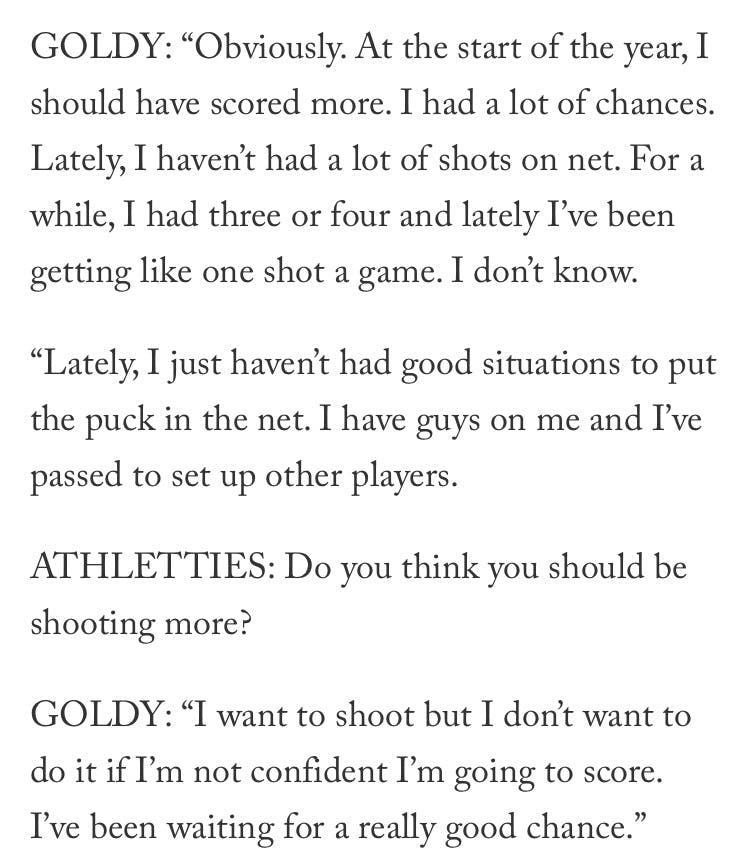
So, about those assists. Goldobin is 3rd on the team in total assists, and 2nd on the team in assists/60 minutes. One criticism I hear often, and the coach specifically pointed to this, was that Goldy needs to be able to produce away from Pettersson. The claim that he only accumulates points because he is riding shotgun with the (future?) best player in the world is certainly believable, since Goldy’s production peaked with Pettersson and Pettersson is an otherworld deity descended to this planet to save the Canucks from despair and desolation.
But this narrative is not sustained by facts (except for the otherworld deity part, which is incontrovertible). The below graph shows the percentage of assists each of Goldobin, Pettersson, and Boeser get from setting up their favourite target for a goal.

The results are very similar for each of these players. Of Goldobin’s 18 assists, 8 of them are on goals scored by Elias Pettersson but 10 of them are not. Petterson has certainly been Goldy’s favourite guy to set up, but that’s partly because Pettersson has scored more goals than anyone else on this team.
If you look at other players’ assists, you find that they, too, have favourite scorers. Of Brock Boeser’s 15 assists, 6 of them are on goals by Pettersson. So, while 44% of Goldy’s assists are on goals scored by a cosmically-gifted alien, the same is true of 40% of Boeser’s assists. Believe it or not, the same can be said of Elias Pettersson, the alien himself, if we examine his assists. His favourite target is Boeser, who has scored 45% of the goals Elias has set up. The numbers do not suggest that Goldy is uniquely dependent on Pettersson. Instead, they suggest that good players play well with other good players, and that the line of Goldy-Petey-Flow clicks well together. Goldy knows it:
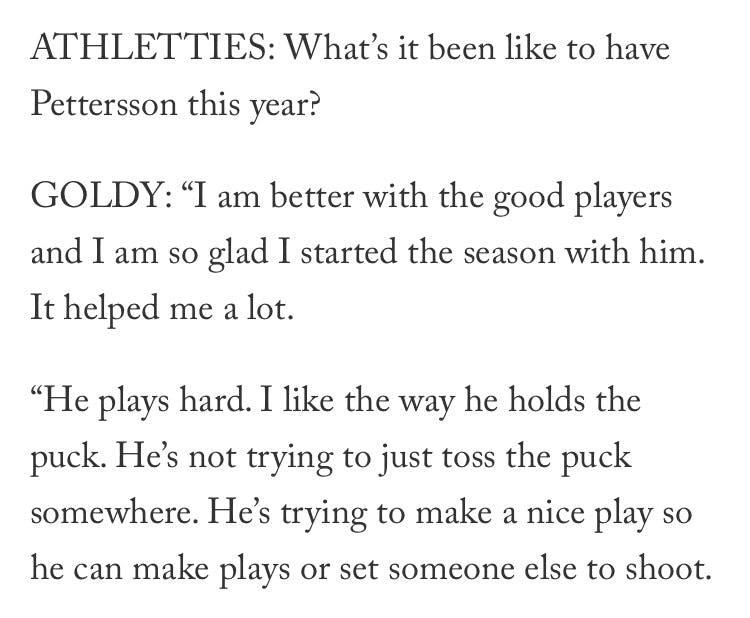
Away from that line, Goldobin’s production isn’t as strong, but that is also true of Josh Leivo, who accumulated 5 points in his first week playing with Pettersson and Boeser and has generated just 1 point since then. Meanwhile, Goldy has continued to produce away from Pettersson, albeit at a slower rate. It also needs be said that his leash got significantly shorter after he was moved off that line, which has meant a major decline in ice time and no doubt a dip in his confidence/comfort, given the repeated benchings. Playing with less-skilled linemates, as in the game when Goldobin was placed on the fourth line with Jay Beagle, will also tend to lower any offensive players’ production.
Conclusion: Goldobin is not Anson Carter. His production is better with Pettersson, as any players’ would be, but he is no more dependent on Pettersson than any other forward on the team.
Goldobin’s strongest asset is his playmaking, so digging into his assists is important since it reflects the most significant contribution that should be expected of him. It is, therefore, reassuring that not only is the share of his assists not unduly weighted to Pettersson goals, it is also well-balanced between primary and secondary assists. 50% of Goldobin’s assists are primary assists, a ratio better than Boeser (46%) though not as strong as Pettersson (65%). This isn’t surprising: we can’t all be powered by a magical crystal from an advanced interstellar civilization.
Even some of Goldy’s secondary assists are sparkling. Here, he creates some pressure on the forecheck which ultimately leads to a weak clearing attempt and a turnover. Then, he collects the puck and makes a quick and crafty pass to Michael Del Zotto who gives the puck to Pettersson for a goal. It’s a secondary assist, but Goldy has his prints all over this.
And even that rate of 50% primary assists is probably lower than it should be. When it comes to setting up his teammates for shots, Goldobin is the Canucks’ best.
According to CanucksArmy’s Darryl Keeping, who tracks a variety of on-ice details, Goldobin leads the team with a rate of 11.13 primary shot assists per 60 minutes. He is even ahead of the Extraterrestrial himself, who ranks second on the team with 10.05 per 60 minutes. Put simply, there is no Canuck who does a better job than Goldy at finding teammates in a position to shoot and getting them the puck. In fact, if his other linemates were as good as Elias Pettersson at scoring goals, he would likely have even more eye-popping assists totals. As it stands, he leads the team with 18.
Travis Green made a point of noting that Goldobin needs to be able to produce away from Elias Pettersson. But the stats suggest that he has done that. The most obvious centre to play with Goldy, if not Elias, is Bo Horvat. Goldobin has assisted on two of Horvat’s 18 goals, but would likely have more but for some brutal luck: the Canucks’ on-ice shooting % when Bo and Goldy are together is under 2%. This is absurdly low (Canucks’ average is around 10%) which suggests that given more time together, Goldy is due to hit paydirt on a whack of assists, with Bo being the likely beneficiary.
No Scrubs
Ok, so we’ve seen the new Capilano Audi ad, but is Goldobin really driving that thing? Or is he a scrub, hanging out the passenger side of his best friend’s ride, trying to holler at Petey? Again, Darryl Keeping’s numbers suggest he’s a driver, not a passenger. One of the most important ways a team sets up scoring chances is by gaining entry to the offensive zone with the puck. Right? Do we agree on this?
Great, because Nikolay Goldobin has the highest percentage of controlled zone entries of any Canuck.
If Goldobin is the weak link when he’s on the ice, you would expect this to show up in his Corsi rating. After all, Corsi is a widely-accepted metric of puck possession, measuring shot attempts for and against when a player is on the ice. In small samples, Corsi can be misleading since a player might be benefiting from the hard work and skill of the players he is playing with. But in larger samples, it tells you which players are consistently part of 5-player units that gain and maintain puck possession and generate scoring chances.
Of Canucks’ regulars this season, Nikolay Goldobin ranks 4th on the team in CF%. Of forwards, he is 2nd, trailing only – you guessed it – The Goalscorer From A Distant Planet. (I have not included Josh Leivo, given his limited sample size. If included, Leivo is #1, followed by Pettersson and Goldobin.)
For a player whose play away from the puck supposedly makes him a liability, Goldobin sure helps his linemates gain the offensive zone and control shot attempts. I’ve been told the Canucks are looking for players they can win with. Gaining the zone and controlling shot attempts is how you win hockey games. If you don’t believe me, check out the team Corsi ratings of the best teams in the NHL.
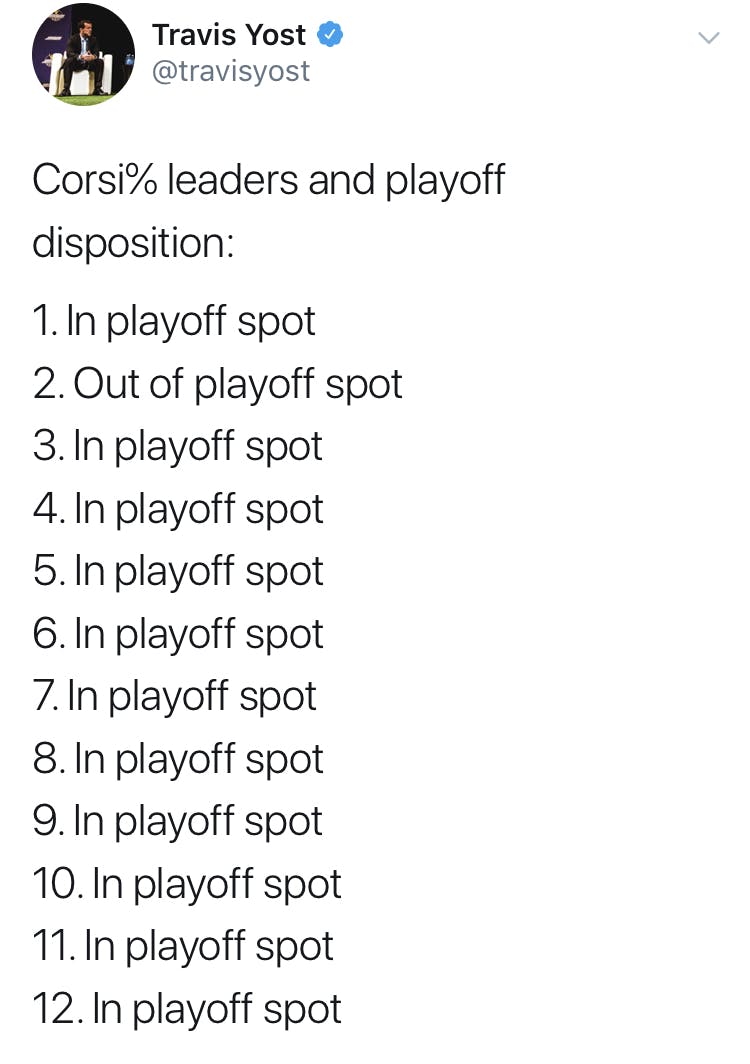
Looks like Corsi tells us something very significant. And Goldy has one of the best Corsi ratings on the team.
Another thing I hear about Goldy is that he makes irresponsible turnovers. He does, I have seen it. So do other players, though. How can we possibly determine whether Goldy does this more egregiously than his teammates? One way would be to look at giveaways and takeaways.
Now I’ll start by placing a caveat here which is that I find the tracking of this statistic often very suspect. Like many people, I am often baffled to discover when a play gets called a “giveaway” (blame is placed on the offensive player) a “takeaway” (blame on the defensive player) or nothing at all. With a statistic as subjective as this, it should always be taken with a grain of salt. Nevertheless, over time and used cautiously, it can add to an overall picture of a player.
When I look at this statistic, I look less at the raw numbers and more at the ratio: is a player gaining possession more often than they lose possession? If so, I’m satisfied. If not… why am I picturing Erik Gudbranson right now?
Yes, Unfortunate Erik has only 6 takeaways compared to 18 giveaways, meaning he is only on the winning side of just 25% of the turnovers he is involved in. But let’s focus on forwards. The chart below shows the percentage of each players turnovers that are takeaways (as opposed to giveaways). Forwards excluded below are those whose sample size is very small (meaning they are not involved in many turnovers in either direction, read into that as you will):
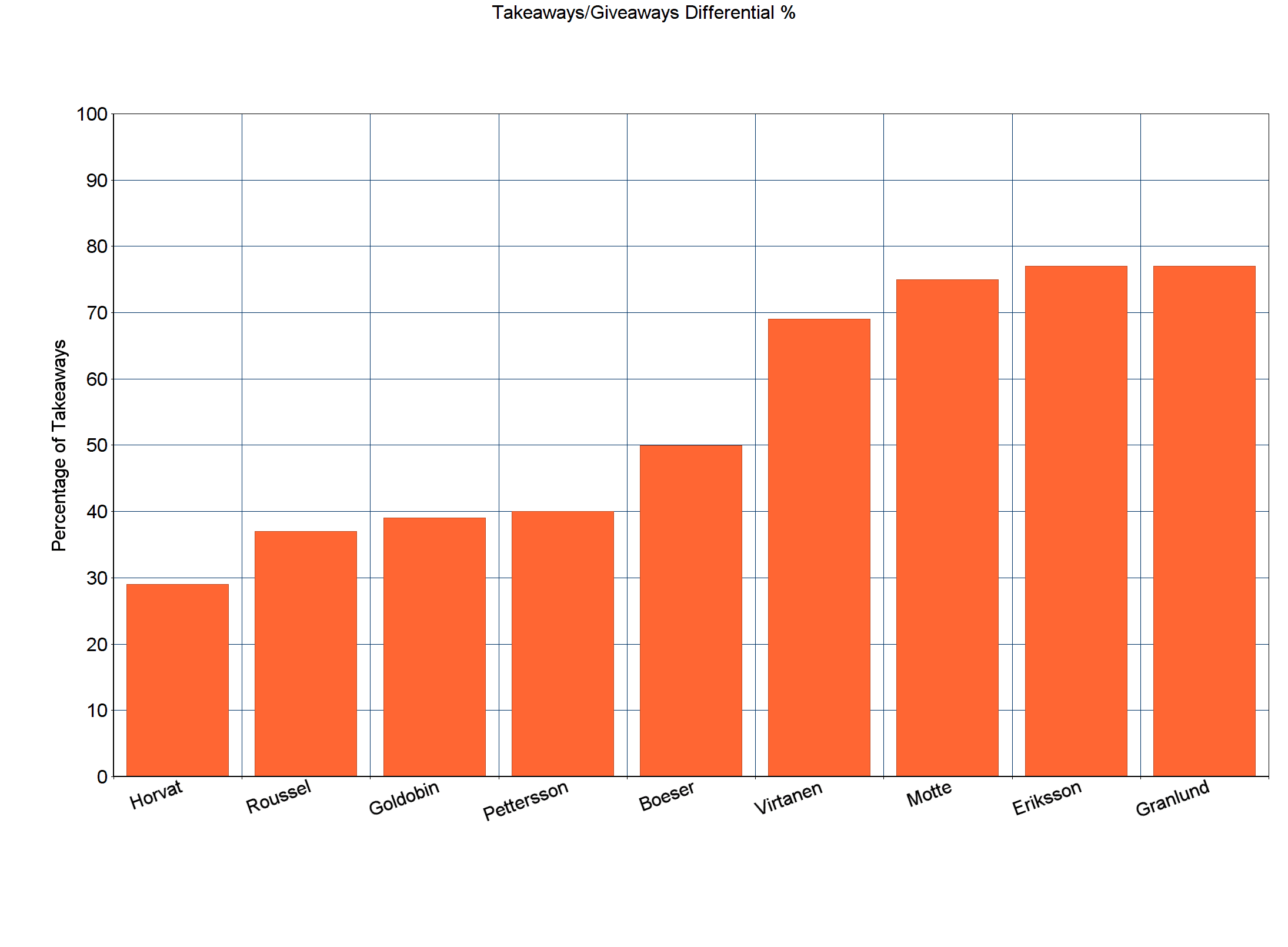
One player who struggles here is, surprisingly, Bo Horvat, whose 11 takeaways and 27 giveaways clocks him in at just 29%. Sometimes a player will look bad in a stat like this because they try to make ambitious plays: Elias Pettersson is going to win the Calder Trophy with ease, but his rating here is only 40%. This is likely because he often elects a higher-risk play and that naturally leads to more turnovers against. Brock Boeser sits at a perfectly balanced 50%, with 19 takeaways and 19 giveaways. Jake Virtanen has the most takeaways on the team, with 35, and lands with a nice rating of 69%. A couple of coach’s favourites do very well in this category: Loui Eriksson and Markus Granlund lead the team with 77% each on the strength of a lot of safe, low event dump-ins.
And Goldobin? His 39% puts him close to Pettersson’s 40% and Roussel’s 37%. There’s definitely room for improvement here and – to the extent that we can take this statistic to heart – I can see where the coach could reasonably expect better. But it is also worth noting that the Canucks’ most effective offensive players are all 50% or below. Goldy sits right in the middle of Horvat, Pettersson and Boeser in this category, so, one would expect there to be comparable fuss made over the turnovers from those players. Or, if we accept that one of the unavoidable consequences of being an effective offensive player is that sometimes you lose the puck, then all four players should be equally forgiven for not being Low Event Loui.
Whither Nikolay?
So, is Goldy being picked on? He has certainly been subject to more harsh, vocal and public criticism from within the organization than any other player in recent memory. Travis Green says he likes Goldobin and is giving him “honest love” to improve his game. There’s no player on this team that can’t improve their game, and Goldy should be considered part of the nucleus of the Canucks future, so I’m all for finding ways to improve his game.
But constantly running him down can be counter-productive. Some players do not respond well to being the coach’s whipping boy, and there is ample evidence that Goldy is one of those players. Alex Burmistrov made a point of saying so as he was exiting the organization, and Goldobin’s agent Igor Larionov recently expressed pointed disappointment with the way Goldy was being treated.
His game has dropped off since November, as he has come under heavier fire from the coach and been demoted through the lineup. What many eye-testers see as laziness – gliding instead of skating full-out – can be seen by another set of eyes as indecision. When a player isn’t sure where they should go and is worried about making a mistake, they will often coast while they try to make that decision.
Is Goldy squeezing-his-stick, double-clutching, walking-on-eggshells, or otherwise underperforming out of fear of making a mistake? Quite possibly. As he told Botchford, a big part of getting better defensively is about knowing where to go and being decisive; that’s not something you can learn overnight, it takes time.
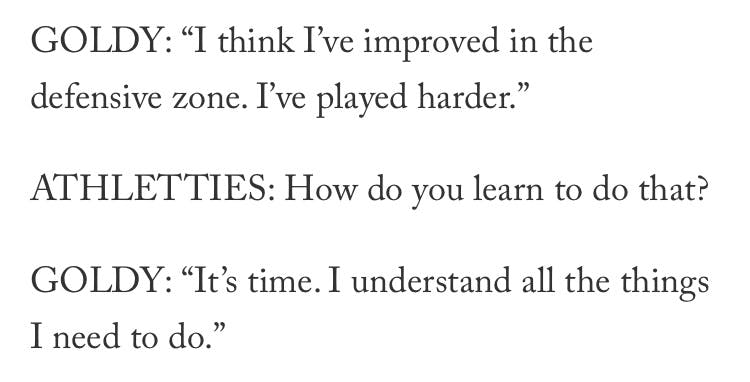
When he knows his assignment, he doesn’t seem to mind skating hard to make a play, as he did here versus the Leafs:
Of course, Goldy isn’t always making plays like this, if he was, we would be calling him Elias Pettersson. He makes mistakes, sometimes even costly ones, and he needs to improve. But is he unique in that? In the game against Buffalo, Ben Hutton scored a goal on his best shot of the year, only to have the goal called back because Jake Virtanen was offside while coasting off on a lazy line change.
Against Edmonton, the Canucks gave up the opening goal on what was one of the weakest defensive efforts I have ever seen by Brock Boeser.
I have a lot of room to forgive young players like Jake and Brock for these mistakes. They’ll learn, they’ll get better. But one can’t help wondering what would happen if Goldobin made the same mistake. Would he be benched? Scratched? Singled out by the coach? When Goldy says he is being picked on, is it because the standards aren’t the same? To be honest, he has a point. The standards have not been the same.
Maybe it’s time to ease up on the kid. The numbers indicate that he is one of the offensive drivers on this team, that he plays well with the best players, and that the team does better when he is on the ice. In fact, Elias Pettersson does considerably better with Goldy than without him: Darryl Keeping has repeatedly reminded us that Pettersson’s Corsi rating is much stronger when he plays with Goldy. Which makes sense, since Goldy is such an effective puck-distributor.
The case for Goldy-as-liability doesn’t hold up very well, and so continuing to drag him for it appears somewhat irrational. Has the coach simply dug in and found himself unable to back down from a position he is now committed to? As a teacher, I know how this can happen. You challenge a student because you think they have more to give, but the student simply cannot give much more at the moment. Now what? Back down and accept that you might have pushed too hard? That your expectations might have been unreasonable? Or maintain your position and punish the student for failing to improve, even if they are, in fact, performing reasonably well? The temptation to hold your ground can be overwhelming, especially once you have publicly invested yourself in a position. Coach Green could well be experiencing that dilemma.
Like Travis, I’d love to see Goldy tighten up his two-way play and get more confident and comfortable with his defensive responsibilities. But that kind of improvement may take time, and in the meantime, I am very satisfied by having a player who sets up goals, because goals win games. Only one Canuck gets more assists per 60 minutes than Nikolay Goldobin. His name? No one knows what his intergalactic ancestors called him, but on this planet, we call him Elias.
Recent articles from Tyler Shipley





